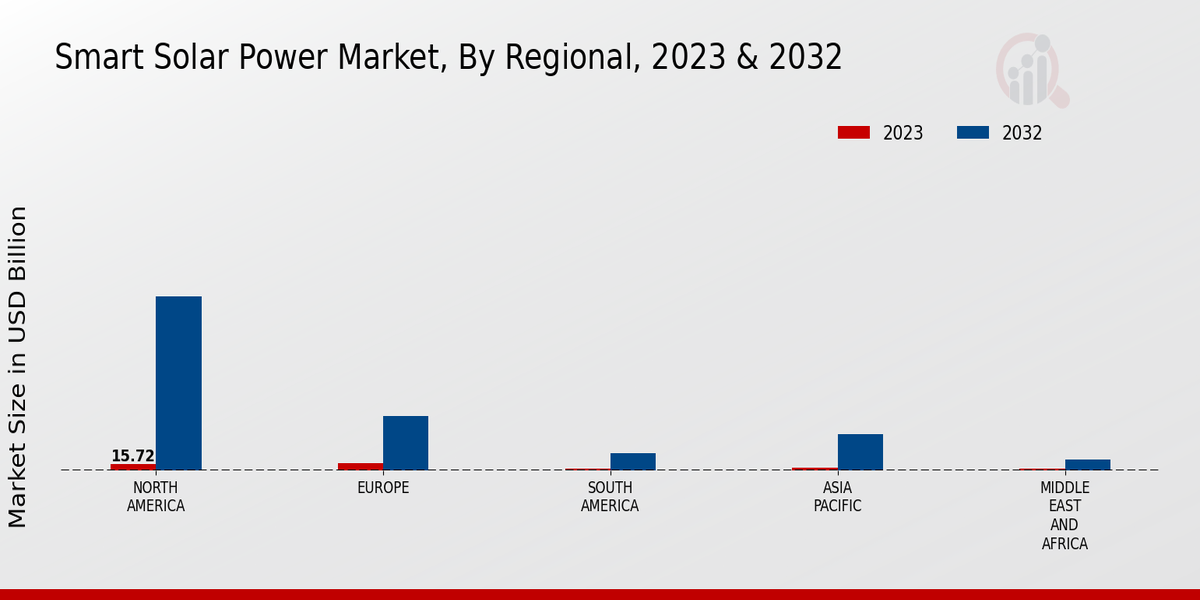Increasing Energy Costs
The rising costs of traditional energy sources are prompting consumers and businesses to seek alternative energy solutions, thereby driving the Global Smart Solar Power Market Industry. As fossil fuel prices fluctuate and environmental concerns grow, solar energy presents a viable and cost-effective alternative. The economic pressure to reduce energy expenses is leading to increased investments in solar technologies. This trend is likely to accelerate the transition towards solar power, as more entities recognize the long-term savings associated with solar installations. Consequently, the Global Smart Solar Power Market is poised for significant growth, reflecting a broader shift towards sustainable energy practices.
Market Growth Projections
The Global Smart Solar Power Market Industry is projected to experience remarkable growth, with estimates indicating a market value of 2593.7 USD Billion by 2035. This growth trajectory is supported by a compound annual growth rate of 34.99% from 2025 to 2035, reflecting the increasing adoption of solar technologies worldwide. The expansion of solar energy infrastructure, coupled with advancements in technology and supportive government policies, is likely to drive this growth. As the market evolves, it is expected to attract significant investments, fostering innovation and enhancing the overall sustainability of energy systems globally.
Growing Environmental Awareness
There is a notable increase in environmental awareness among consumers and businesses, which is significantly influencing the Global Smart Solar Power Market Industry. As climate change and environmental degradation become pressing global issues, individuals and organizations are more inclined to adopt sustainable practices, including the use of solar energy. This heightened awareness is driving demand for solar power solutions, as stakeholders seek to minimize their carbon footprints. The Global Smart Solar Power Market is likely to benefit from this trend, as the collective push for greener energy sources continues to gain momentum, further solidifying solar energy's role in the global energy landscape.
Government Incentives and Policies
Government incentives and supportive policies play a crucial role in driving the Global Smart Solar Power Market Industry. Many countries are introducing tax credits, rebates, and grants to encourage the adoption of solar energy. For example, the United States has implemented the Investment Tax Credit, which allows homeowners and businesses to deduct a significant percentage of solar installation costs from their federal taxes. Such initiatives not only lower the financial barriers to solar adoption but also stimulate market growth. As a result, the Global Smart Solar Power Market is expected to witness substantial expansion, with a projected market value reaching 2593.7 USD Billion by 2035.
Rising Demand for Renewable Energy
The Global Smart Solar Power Market Industry is experiencing a surge in demand for renewable energy sources as countries strive to meet climate goals and reduce carbon emissions. Governments worldwide are implementing policies and incentives to promote solar energy adoption, which is reflected in the projected market value of 95.6 USD Billion in 2024. This increasing demand is driven by the need for sustainable energy solutions, as well as the declining costs of solar technology. As more consumers and businesses seek to transition to cleaner energy, the Global Smart Solar Power Market is likely to expand significantly, fostering innovation and investment in solar technologies.
Technological Advancements in Solar Power
Technological innovations are a key driver in the Global Smart Solar Power Market Industry, enhancing the efficiency and affordability of solar energy systems. Advances in photovoltaic technology, energy storage solutions, and smart grid integration are making solar power more accessible and reliable. For instance, the development of bifacial solar panels and improved battery storage systems has the potential to increase energy output and optimize energy use. These advancements not only contribute to the market's growth but also support the projected compound annual growth rate of 34.99% from 2025 to 2035, indicating a robust future for solar technology.
























Leave a Comment